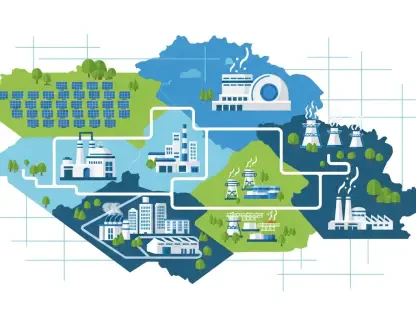As climate change continues its relentless progression, extreme heat events have increasingly challenged nations across the world, including the United States, Greece, and the United Kingdom. These occurrences serve as a stark reminder of the urgent need for adaptive measures and comprehensive responses to environmental shifts. From sizzling temperatures that disrupt daily living to wildfires that lay waste to landscapes during critical tourist seasons, these countries grapple with a new normal where severe heat is not the exception but a growing trend. The phenomenon, underscored by the atmospheric anomaly known as a heat dome, pushes communities to the brink, emphasizing the necessity of coordinated efforts to mitigate its impacts.
Fires and Consequences in Greece
In Greece, the situation presents a stark image of adversity, as wildfires blaze unabatedly across the island of Chios. This disaster, exacerbated by ferocious winds, has prompted authorities to order evacuations close to the village of Karyes. The fires threaten not only the serene landscapes and homes but also valuable cultural and economic assets, including mastiha production. Peak tourist season magnifies the urgency of firefighting efforts, as teams work tirelessly to limit damage and protect cherished sites that serve as pillars of the island’s economy. Ensuring the safety of both residents and visitors becomes paramount, and the efforts of firefighters symbolize the delicate balance between natural beauty and environmental calamity.
The flames in Greece also highlight vulnerabilities in infrastructure and emergency preparedness. Declarations of emergency emphasize these challenges, requiring robust strategies to safeguard people and preserve local heritage. As fires become more frequent and intense, improved communication, resource allocation, and preventive planning are essential for minimizing damage. With climate change ushering in prolonged dry spells and high temperatures, the likelihood of such events increases, demanding proactive measures on the part of governments and communities alike. Learning from the past and advancing technology play critical roles in forming effective response protocols to address these unforeseen yet increasingly common challenges.
Heat Domes and Urban Responses in the US
Across the Atlantic, the United States braces for the oppressive conditions driven by a heat dome, an occurrence characterized by a high-pressure system trapping hot air over regions like Chicago, Colorado, Nebraska, and Kansas. The relentless heat threatens to overwhelm cities, placing public health systems under severe strain. Chicago, for instance, revisits past lessons from previous tragedies, such as the heat wave that led to 700 fatalities three decades ago, by enhancing cooling centers for vulnerable populations. These centers are vital for protecting the elderly, children, and individuals with existing health issues, ensuring that safety measures align with the contemporary understanding of heat-related threats.
Local governments in the US understand the importance of comprehensive safety strategies amid extreme heat forecasts. Adjusting public working hours, especially for outdoor labor, becomes crucial in preventing heat-induced illnesses. With Denver temperatures projected to soar beyond 100 degrees Fahrenheit, health advisories are essential to guide citizens on effective precautions. The broader implications extend beyond individual safety to influence economic productivity and infrastructure resilience. These episodes underline the urgency for cities to innovate, ensuring that public systems are equipped to withstand and adapt to rising temperatures, ultimately fostering environments that prioritize health and well-being.
UK Insights and Energy Concerns
The United Kingdom faces its own set of challenges with the increased likelihood of drastic temperature spikes. The UK Met Office’s analysis reveals a significant tenfold increase in the probability of such episodes compared to previous decades, raising alarm about imminent threats to public health and safety. As scientists predict potential fatalities from heat waves, the interconnected nature of climate phenomena becomes apparent, impacting policy decisions and emergency preparedness across national borders. This rising frequency of heat events demands robust mitigation plans, including strategic temperature monitoring and public education, to ensure readiness and resilience.
A notable concern shared by all regions affected by extreme heat is the undue stress placed on electricity grids. The surge in demand for air conditioning and cooling equipment poses immediate challenges to power sectors, calling on utilities to innovate and strengthen aging infrastructure. The anticipated tripling of electricity consumption over the next decade underlines the imperative for decisive action to expand capacity and improve efficiency. Bridging this energy gap demands collaborative efforts from technology, policy, and community spheres to sustain momentum in meeting climate goals without compromising public comfort or safety during episodes of extreme temperature.
Seeking Sustainable Solutions
As climate change advances without pause, extreme heat events increasingly challenge nations globally, including the U.S., Greece, and the U.K. These events are stark reminders of our urgent need for adaptive strategies and comprehensive responses to evolving environmental conditions. These soaring temperatures disrupt daily activities while wildfires devastate landscapes, particularly during peak tourist seasons. The situation is evolving into a ‘new normal,’ where severe heat waves are no longer rare exceptions but rather a growing trend. Such phenomena, intensified by atmospheric anomalies like the heat dome, push communities to their limits, underscoring the essential need for coordinated, effective efforts to reduce their impacts. Effectively addressing these challenges requires both immediate and long-term strategies that are sustainable and adaptable to continually changing conditions. Collaboration among nations and communities is crucial for crafting effective solutions that combat the severe consequences of a warming planet.









